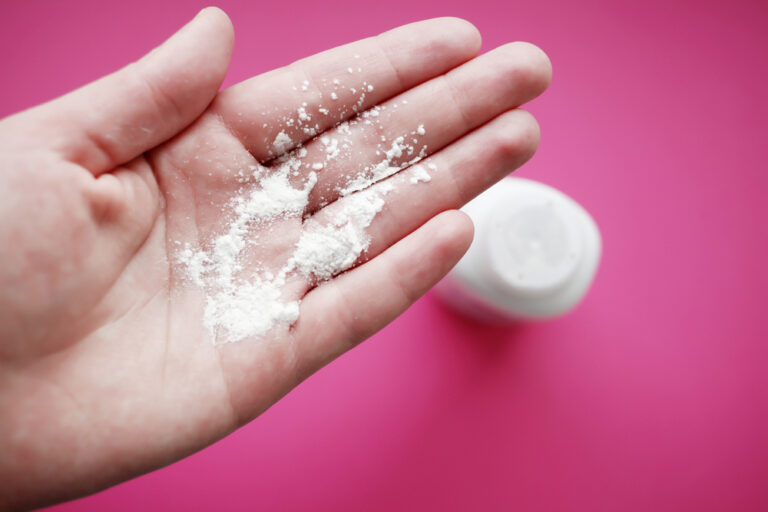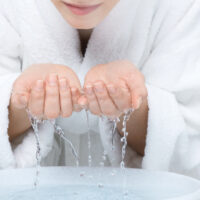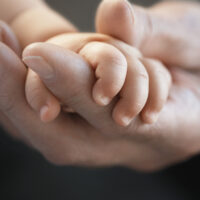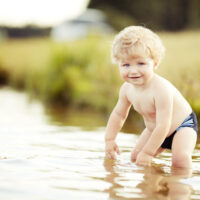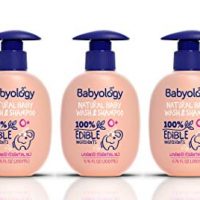The clean, fresh smell associated with a freshly powdered baby is a scent that melts hearts. Not only does baby powder smell fresh, but it also keeps your little one’s diaper area dry – something that is essential in preventing diaper rash.
In light of the lawsuits regarding talcum-based baby powders, we took a look at some of the much better alternatives for best baby powder.
Take a look at all the top baby powder picks.
Always check with your pediatrician before starting any products on your baby.
Best Organic Talc-Free Baby Powders
Era-Organics Organic Baby Powder is made from cornstarch, a common ingredient in baby powder derived from corn, however, Nature’s Baby Organics Baby Powder is made from tapioca starch which comes from the root of the cassava plant.
Era Organics Organic Baby Powder
Era Organics Organic Baby Powder uses a blend of natural ingredients that soothes skin before and after a diaper rash. It promotes healing but also can be used for daily use. As an added benefit, it is USDA certified organic.
The Ingredients
The active ingredients in this Era Organics power include cornstarch, kaolin clay, arrowroot, rosemary, and calendula. Cornstarch soothes and dries while the kaolin clay helps create a dry environment without stripping your little one’s skin of natural oils.
Arrowroot is a known anti-inflammatory and antioxidant, which soothes irritated skin and encourages healing. It is also an antiseptic, which is useful in cleansing bacteria from the diaper area.
Rosemary is included to rehydrate your little one’s skin and encourage healing. It is also known for its ability to prevent infection.
Finally, calendula has anti-inflammatory properties that reduce redness and inflammation. It also has antiviral and antibacterial properties that prevent infection and inhibit bacterial growth.
What this doesn’t have is many common harmful ingredients for your baby’s skin. It is free of toxins, dyes, perfume, sulfates, parabens, petroleum, alcohol, and mineral oil.
Other Considerations
The soothing, healing, and antibacterial ingredients in this product let it be used for dry, cracked, and chafed skin. Though it is a dry powder, it moisturizes the skin and encourages healing.
Additionally, the application of the powder is more effective than others. It absorbs into the skin instead of clumping. The powder is also fragrance-free, however, some parents do not like the texture, which is not as fine as some other powders.
Another great thing about the Era Organics company is that they stand behind their company with a guarantee. If you return within 60 days, you get your money back with no questions asked. You can also feel good about their commitment not to test their products or its ingredients on animals.
The downside of this bottle is the size and cost. Even though it is more expensive than other powders, it is only a 3-ounce bottle.
Pros
- Free of fragrances, dyes, and other harmful ingredients
- Absorbs well into the skin
- Dries the skin without absorbing natural moisture
- Organic ingredients that soothe, dry, and promote healing
- Money-back guarantee for 60 days
Cons
- Expensive, especially for the size
- Grittier texture than some other powders
- It does contain potential irritants/allergens
Bee All Natural Organic Baby Powder
Bee All Natural Organic Baby Powder prides itself on using great ingredients that don’t include preservatives, added scents, petroleum, or mineral oil.
The Ingredients
Enjoy knowing this baby powder is made from all organic “food grade” ingredients: Arrowroot, Calendula, Chamomile, Plantain Leaf, and Marshmallow Root powders. All USDA Certified Organic by OEFFA. Of course, the Bee All Natural Organic Baby Powder is talc-free and safe to use on cloth diapers too.
Other Considerations
Keep in mind this is for a 4-ounce bottle so it is a travel-size baby powder.
Unlike some baby powders, this baby powder is truly unscented for those who don’t want to deal with any sort of fragrance.
Pros
- Unscented
- USDA Certified Organic by OEFFA
- Absorbs moisture and nourishes
- Food grade ingredients
Cons
- 4 ounces (travel-size)
- Price is a bit high for the size
- It contains potential irritants/allergens
Nature’s Baby Organics Silky Dusting Powder, 2 Pack
Nature’s Baby Organic Silky Dusting Powder is a truly fragrance-free option. Unlike the other powders mentioned on this list, this dusting powder is made of tapioca starch instead of cornstarch.
The Ingredients
The tapioca starch works as a drying ingredient, absorbing moisture in a natural way. The powder also has organic aloe and chamomile, which have soothing properties that will calm redness and irritation, while promoting healing.
This powder by Nature’s Baby Organics also is made using only organic ingredients as certified by the USDA. It is also free of synthetics and contains only vegan ingredients.
Other Considerations
As with some of the other organic brands, you pay a little more for this powder. Another downside is the design of the container. There is a smaller area and a larger area on top for application. The holes in the smaller area are not big enough to let you easily powder your body, while the larger area is too big for application.
A positive about this powder is the consistency. While it is not as fine as you’d associate with traditional talc powder, it does have a pleasant texture. It is also less likely to create a cloud of powder than traditional powders.
Another positive is the fragrancethere isn’t one. It is perfect for people with sensitive noses or who do not want to smell like baby powder.
Pros
- Doesn’t create a large cloud of powder
- Set of 2
- Uses only organic ingredients
- Tapioca starch instead of cornstarch
- Fragrance-free formula
Cons
- Expensive compared to some other brands
- Difficult to apply because of container design
- It contains potential irritants/allergens
Best Talc-Free Baby Powders
Johnson’s Baby Powder with Naturally Derived Cornstarch comes in a 15 oz container with a great price tag so you get a lot of bang for your buck, while Made Of Organic Baby Powder is in a 3.4 oz container with a much more expensive price tag.
Caldasene Medicated Protecting Powder
Cornstarch powder and zinc oxide provide protection in Caldasene Medicated Protecting Powder. It has a fine texture that applies easily and protects skin from diaper rash, chafing, and irritation.
The Ingredients
Cornstarch provides a moisture-absorbing barrier for your baby, while zinc oxide has medicating properties to prevent infection and encourage healing.
Caldasene’s medicated powder also has aloe vera and chamomile, which work together to soothe and nourish the skin. Fragrance is also added.
Other Considerations
This is ideal for a daily powder for protection or as a treatment when your little one has a diaper rash. It repels outside moisture without drying out your baby’s skin. It also works for chafing (and sand removal) so it’s perfect for the whole family.
This has a fresh scent that is refreshing, though it can be overpowering to some noses. Caldasene does offer a clean scent in the same line which may be better for sensitive noses.
As a healing powder, this excels. Many parents report an improvement in their little one’s rash after a single use. Others are disappointed that the newer formula no longer contains talc, though that was removed for safety issues.
One downside is that the amount of powder inside the container does not match the outside. It is about half-full. This powder also becomes cakey with moisture.
Pros
- Zinc oxide and cornstarch repel moisture
- Very effective in soothing sore bottoms
- Aloe vera and chamomile nourish the skin
- Prevents chafing
Cons
- Cakes on skin with moisture
- Container is not full
- Strong fragrance
- It contains potential irritants/allergens
Made Of Calming Baby Powder
For parents of babies with sensitive skin, Made Of Calming Baby Powder prevents irritation from chafing using all-natural, vegan ingredients. They are Leaping Bunny certified for their commitment to producing products cruelty-free to animals at every step of the process.
The Ingredients
Made Of uses a blend of drying ingredients including cornstarch, baking soda, arrowroot powder, and kaolin clay. They dry while nourishing your little one’s skin. Baking soda is a natural deodorizer and the arrowroot powder has antibacterial properties that stop bacterial growth and infection.
Other ingredients include non-GMO tocopherol, which is Vitamin E, aloe vera, and argon oil. Unlike plant extracts, these are nourishing ingredients that do not cause irritation. Additionally, they promote healing and soothe redness if your baby’s bottom is already irritated.
Now that we’ve talked about everything that is in Made Of baby powder, let’s talk about everything that is not. It is free of any synthetic fragrances, sulfates, parabens, and GMO ingredients. It is also soy-free and nut-free, making it perfect for babies with allergies.
Other Considerations
The packaging is very clear about what is and is not in the product, as well as certifications the company has earned. You really know what you are going to be buying and putting on your little one’s butt. You can also feel great about it.
One downside is that the bottle sold is rather small, so while this works well for the occasional diaper rash, it may be out of some parents’ price range for a daily lotion. The bottle is just 3.4 ounces and it is more expensive than several other options.
Pros
- Leaping Bunny certified
- Soy-free and nut-free
- Ingredients dry and nourish your baby’s skin
- Very clear labeling
- Vegan
- Rated 1 by EWG (Environmental Work Group)
Cons
- Expensive, especially for the size
Johnson’s Baby Powder with Aloe and Vitamin E
The Johnson’s company has been helping parents care for their babies for more than a century. Johnson’s Baby Powder with Aloe and Vitamin E is a cornstarch-based powder. It is free of harmful ingredients like dyes, parabens, phthalates, and sulfates.
The Ingredients
In addition to cornstarch, ingredients like aloe and Vitamin E are included to provide a mild fragrance and leave your little one’s skin feeling baby soft.
This Johnson’s baby powder has been reformulated with fewer ingredients. It is nice to know that all the ingredients included are good for your little one’s skin. They are also hypoallergenic.
Other Considerations
Another benefit of this powder is that the silky smooth texture works well in removing sand after a beach outing, as well as for absorbing excess oils like a dry shampoo in adult hair. Who doesn’t love a product that baby and the whole family can use?
For people who are familiar with baby powder’ scent, they may be disappointed that the original formula no longer has this. There is a slight fragrance from the aloe that is pleasant to the nose, but the original baby powder scent came from the talc that was removed.
Finally, while the smooth powder feels nice on the skin, it can be difficult to get it to stick. This can make applying different, especially since you should avoid getting the particles in the air.
Pros
- Powder has a smooth texture that softens skin
- Wide range of applications
- Natural ingredients and fragrance
- Free of dyes, parabens, sulfates, and phthalates
- Hypoallergenic
Cons
- No baby powder’ scent
- Not as sticky as some other powders
- It contains potential irritants/allergens
- Rated 3 by EWG
Burt’s Bees Natural Dusting Powder
Burt’s Bees has a reputation for providing high-quality, natural products that you can feel good about using and Burt’s Bees Natural Dusting Powder meets that standard. It contains natural ingredients that will nourish your little one’s sensitive bottom.
The Ingredients
Cornstarch, bark powder, and clay (listed as montmorillonite and bentonite) come together in this powder to help dry your little one’s skin without removing natural moisture. It also has natural oils, including rose extract and myrrh extract that have moisturizing and antibacterial properties.
Baking soda is also included, which dries and has deodorizing properties. Something to note is that extracts can be irritating to sensitive skin.
This product is also free of ingredients like parabens, phthalates, petrolatum, and SLS. Even though the ingredients are natural, many of the ingredients have their scientific name on the ingredients list and this can be hard to read and understand what is in the powder.
Other Considerations
For parents worried about choosing a quality baby powder, you’ll appreciate that Burt’s Bees products are pediatrician tested and proven gentle on your little one’s skin.
This dusting powder has a fine consistency. It also sticks well, which means you can apply a thick layer to absorb moisture without worrying about making a mess.
The natural fragrance included in this powder is lightly scented and pleasant. However, some people do not like the fragrance and think it is too sweet.
Pros
- Pediatrician tested for safety and effectiveness
- Dries without removing natural moisture
- Free of harmful ingredients
- Sticks well and has a fine consistency
Cons
- Fragrance is too sweet smelling for some people
- Extracts can be too harsh for some babies’ skin
- It contains potential irritants/allergens
- Contains fragrance
- Rated 3 by EWG
Johnson’s Lavender Baby Powder with Naturally Derived Cornstarch
Babies with frequent bottoms might benefit from a naturally derived powder like Johnson’s Lavender Baby Powder with Naturally Derived Cornstarch. It is hypoallergenic and dermatologist-tested for use on sensitive skin.
The Ingredients
Drying cornstarch creates a barrier on your little one’s bottom, protecting it from their bowel movements. It also contains lavender for a fresh and relaxing scent. It is mild and should not irritate your baby’s skin. It is a fresh scent that is not overwhelming, though it does not smell like typical baby powder.
This baby powder is free of parabens, phthalates, dyes, and sulfates.
Other Considerations
This is a scented baby powder so keep that in mind if you’re wanting to avoid fragrance and go the unscented route.
On the other hand, if you’re looking for a nice fragrance, the lavender scent in this baby powder smells great and is said to last throughout the day.
Pros
- Nourishes and encourages healing
- Prevents diaper rash
- Naturally-derived Cornstarch
- Hypoallergenic and dermatologist-tested
- No parabens, phthalates, dyes, and sulfates
Cons
- Only 4 ounces (travel-size)
- Fragrance included (if you’re wanting unscented)
- It contains potential irritants/allergens
- Contains fragrance
- Rated 3 by EWG
Comparing Baby Powders
The table below compares only the recommended products on this page. A low or high Price means it is low or high compared to the other products listed. The Popularity Score reflects how often readers click on and buy the product. The Quality Score is our assessment of the overall performance and satisfaction with the product compared to others in the table.
| Bee All Natural Organic Baby Powder | 4.9 | 8.6 | 25.99 |
| Made Of Calming Baby Powder | 9.3 | 9.0 | 11.99 |
| Era Organics Organic Baby Powder | 9.8 | 8.8 | 9.49 |
| Johnson's Lavender Baby Powder with Naturally Derived Cornstarch | 9.6 | 9.4 | 7.99 |
| Caldasene Medicated Protecting Powder | 9.9 | 9.4 | 5.22 |
| Johnson's Baby Powder with Aloe and Vitamin E | 9.9 | 9.4 | 4.70 |
| Burt's Bees Natural Dusting Powder | 3.9 | 8.0 | - |
| Nature's Baby Organics Silky Dusting Powder, 2 Pack | 8.8 | 9.0 | - |
FAQ
Is baby powder safe to use?
The American Academy of Pediatrics does not recommend baby powder usage, instead preferring a petroleum-based alternative. However, while petroleum-based products do create a protective layer between your little one’s skin and their diaper, they do not create a dry environment that is good for certain types of rash.
For parents who do want to use baby powder, it must be kept out of the air to remain safe. Even non-toxic and organic ingredients can be harmful when inhaled, aggravating respiratory conditions and even causing choking. The AAP recommends applying powder to your hands and then your little one’s bottom.
The earlier safety concerns were caused by the presence of talc in baby products, which had cancer-causing asbestos in it until the 1970s. There is a link between talc and ovarian cancer. As researchers have not disproven the talc itself caused cancer, many manufacturers recalled their talcum-based products and replaced them with cornstarch-based powders.
Many of the ingredients included in these products are controversial or have limited or no data/research on use for babies. Some ingredients have been linked to health problems. Many products have not been evaluated by the FDA. Since no studies have been conducted with these products on babies there is no absolute certainty that these are 100% safe. Always consult with your pediatrician before starting any products on your baby.
Since the FDA does not regulate cosmetic products, the Environmental Work Group (EWG) has created a database of products. It offers information on the most popular products and ingredients, such as whether the product is an irritant/allergen or linked to organ/reproductive toxicities. It rates products from 1 to 10, with 1 being the least toxic. It is best to stick to products that rate EWG verified, 1 or 2.
When should I use baby powder for a diaper rash?
Parents who use baby powder should use it to create a dry environment in the diaper. It can be used to prevent chafing or soothe a rash. Baby powder may be especially useful in the summer, especially if the folds of your little one’s skin is susceptible to heat rash.
You should not use baby powder if it makes your little one’s rash worse or if they have a yeast or bacteria-based infection. Many baby powders contain cornstarch, which can encourage candida growth.
Why does my baby have a diaper rash?
Diaper rash has many causes and determining the cause of your little one’s rash is important for finding the right treatment. The most common causes of diaper rash include:
- Wetness- Keeping up with diaper changes is a great preventative measure for wetness. However, some babies have sensitive skin. Bacteria in the stool is broken down by urine, creating harsh ammonia. If your little one has frequent bowel movements, they are more susceptible to diaper rash.
- Diaper irritation- Chemical sensitivity and chafing may be caused by your little one’s diaper. Chafing happens from a poor-fitting diaper. Chemical sensitivity also causes a rash. This is a time when it is best to switch diaper brands/fits to solve the problem. You can find out more about chemicals in the top diapers and organic diaper alternatives here.
- Yeast or bacterial infection- Yeast and bacteria thrive in warm, moist environments. You may need to take your baby to a doctor if they have one of these conditions, especially if they have open sores or are in extreme pain.
- Antibiotic use- If you are breastfeeding and using antibiotics or if your little one needs antibiotics for a cold, it can cause diaper rash. Your baby’s body is an ecosystem. Antibiotics kill bad bacteria, but they kill the healthy bacteria that keep yeast in check as well. Diarrhea is also a common symptom of antibiotics, which will aggravate your little one’s bottom.
- New foods- Trying new foods is an exciting part of bonding with your baby. As their digestive system develops, however, some foods have higher acid content or react badly in your little one’s belly. When your little one passes the food in their stool, it causes diaper rash.
How else can I keep my baby’s bottom dry?
For parents who do not want to risk using baby powder, the easiest way to keep your baby’s bottom dry is naturally. Let their bottom air out for a few minutes between changings and pat their bottom instead of rubbing it to avoid irritation.
In warmer months and around the house, you can also let your little one go completely natural. Place a pad under them and let them play as nature intended.
Even though dryness is important, using a cream with zinc oxide or petroleum can also create a protective barrier on your little one’s skin that prevents irritation.
How to Use Baby Powder
Many manufacturers have discontinued their use of talcum powder in baby products, especially as there are no conclusive results regarding the link between talc and ovarian cancer.
Even so, there is a risk of inhalation when using traditional baby powders. If your little one inhales baby powder, it can harm their lungs.
Most manufacturers have switched to cornstarch instead, which has larger particles than talcum. Even so, it’s important to use baby powder without releasing it into the air around your child. The fine particles can irritate asthma and cause lung damage.
The WebMD recommends that parents using baby powder apply it to their own hands first, then powder their baby’s bottom. Alternatively, buy a powder duster and apply the powder to that, then your little one’s bottom.
You should also wipe away excess powder between changes, especially baby powder in the folds of your little one’s skin. Too much baby powder causes irritation instead of preventing it.
Proper storage of baby powder is also important. Even though baby powder generally contains non-toxic ingredients, its ability to be inhaled makes it dangerous. Keep it out of the reach of your little one, as well as their siblings.
